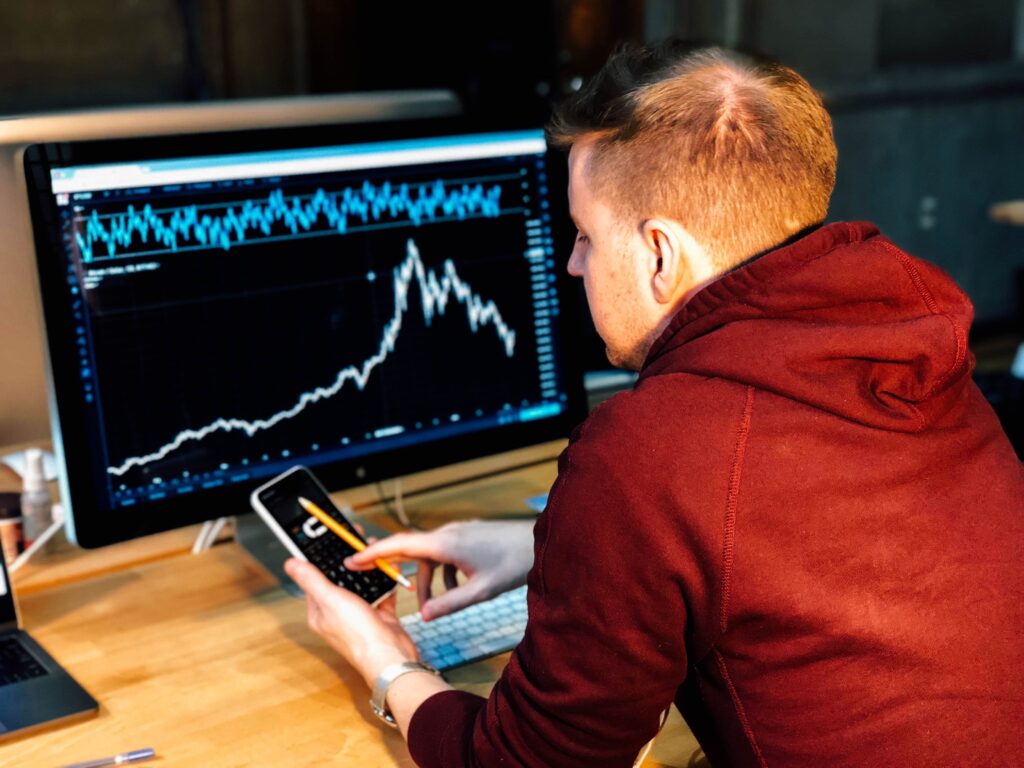Hello! Lately, I’ve been getting into the world of investing since I now have a steady stream of income and want to set myself up for the future. Making my money work for me now so that I have comfortable streams of wealth in the future is one of my current goals. I don’t want to have to fully depend on my job for stability.
We’ve also seen long periods of uncertainty as well as big, unpleasant surprises (COVID-19 *cough* *cough* — no pun intended). Many of us have struggled. Some more than others.
No matter what your age or financial situation, we can all reap the benefits of investing so that we can comfortably handle the unfortunate surprises that will continue to rock our financial boat for years to come.
Don’t be scared!
A lot of people associate investing with risk. I mean, it does seem safer to shovel your money into a bank instead of pouring it into some stocks that may win you some extra money (or alternatively, lose you money).
We’ve all heard the campfire-flashlight-style ghost stories of people going broke pouring all their hard-earned cash into a stock their buddy at work told them was going to triple their money overnight. I remember back in high school when the craze over Bitcoin reached its peak, a classmate told the story of her grandfather shoveling his entire retirement into Bitcoin and losing almost all of it in a matter of weeks.
Fear not! These deterring stories only happen to those of us with no financial intelligence. It actually is surprisingly easy to make your money work for you in the stock market in a way that has very little risk.
Okay, tell me how!
Investing doesn’t have to be complicated. In fact, it can be entirely automated. As easy as scheduling a withdrawal from your account or divying up your paycheck once a month into a few carefully selected funds that will almost guarantee your success. Mind you, I say almost because it really depends on how you select your investments.
Determining your risk tolerance
This might sound cliche but determining your level of acceptable risk is the most important first step you can take when getting started with investing.
When your portfolio dips down a few points one day, are you gonna shit the bed and move all of your money back to the bank? Or, are you going to keep your head, ride out the storm, and maybe even seize the opportunity to buy more assets on sale?
Measuring your risk tolerance really boils down to two things:
- Time
- Emotion
Time
When I say time, I’m not just referring to how long you have to invest. I’m sure if you’ve tried to get your foot in the door into the world of investing, you’ve heard sources tell you that the younger you are the better. With time on your side, you can handle more risk.
This has its truths. With more time, you will be able to ride out the storm. The market has a way of going up and down, but for the past 100 years, it has grown by an average of 10%. And this trend doesn’t seem to be slowing down anytime soon.
More importantly, when I refer to time, I am referring to how much time you are willing to put into investing. Knowledge is the true metric of one’s risk tolerance. It doesn’t matter if you’re 18 or 118 years old, if you are able to invest in businesses wisely and develop a strategy that works for you, you are certain to find success.
Emotion
Your emotional state is also a big player in your risk tolerance. The market is fueled by emotions. Therefore it is constantly subjective to going up and down.
This is because humans determine stock prices — not businesses. Sometimes the stock price could far exceed the value of the business and other times, the price could be lower than what the business is worth.
If you can manage your emotions and ignore the swings of the market, you will make the most logical (and profitable) decisions. Just like how you use knowledge to build your risk tolerance, you can use logic over emotions to afford higher levels of risk as well.
There are really two paths you can choose:
- You can stare at your phone and have mini-heart-attacks when the ticker moves slightly down or brief moments of relief when it moves slightly up.
- Or, you can trust that the business you invested in will fill your pockets no matter what the market is doing.
Just know that your risk tolerance is not finite. You can build it up so that you can take on more risk and thus, reap higher rewards.
How I invest
Okay, now we’ve gotten through some theory, it’s time to give you some practical examples so you can get started ASAP. Just keep in mind, there are thousands of strategies out there. This is just how I do things. You can follow exactly what I do, but always think for yourself when making important financial decisions.
Choosing a broker
Before you are able to put your money into the stock market, you need a broker to actually buy the stocks. Choosing a broker really depends on how you invest.
For me, I’m not overly concerned with charts and graphs and I don’t really care how fancy the user interface is. I just want to buy stocks with as little fees as possible. So, my weapon of choice: Fidelity.
I highly recommend you get started with Fidelity because their fees are almost non-existent (which is extremely important if you want to maximize profits). It’s also relatively easy to use. You certainly don’t want to get overwhelmed with fancy features for technical analysis when you’re just getting started.
But of course, do your own research when picking a broker. Maybe you need fancy tools and don’t care about fees (a stupid approach if you ask me but more on that in a later post).
Choosing funds
Choosing stocks can be scary. I mean, it can be a daunting task to find the right business to invest your hard-earned cash into when there are thousands to choose from on the market today.
But with today’s selection of ETFs and mutual funds, you can easily buy a bundle of stocks so you don’t have to worry about diversification. Diversification is an easy way you can manage risk when investing. Instead of betting on one stock, you automatically spread your money out into multiple, so if one member of your team takes a hit, the rest will pick up the slack.
When picking fund types, it really is easy as 1,2,3:
- Bond Fund: A cushion that can give you essentially a guaranteed return by allowing you to loan money
- Index Fund: A bundle of stocks that tracks the market (like the S&P 500).
- International Fund: A bundle of stocks from markets outside of the US.
With these three types of funds, you’re pretty much guaranteed to have consistent returns over the long run. In full transparency, I invest in Fidelity’s FXAIX (Index Fund) and FSPSX (International Fund). I don’t currently invest in bonds just because I’m young and plan on holding these positions for a long time (probably more than 10 years).
When you’re choosing funds, the most important considerations are taxes and fees. Because these funds are managed by fund managers, you want them to be managed as little as possible. This maximizes your return by lowering trading fees as well as taxes that come with selling stocks.
The two most important numbers to consider are operating expenses and turnover ratios. These are typically expressed as a ratio or percentage. A good rule of thumb is to keep these as low as possible.
There’s nothing usually special about these types of funds as they aren’t trying to beat the market or do anything fancy. So, when choosing between different funds, just go with what will maximize your returns.
If you want to be entirely hands-off, then this selection might satisfy you. But, if you like managing your portfolio and choosing individual stocks, you can use these funds as a core and then invest in other ETFs or stocks of your choosing.
Investing
Now you know what to invest in but how do you know where and when to send your money.
For me, I like to transfer a fixed amount of money to my brokerage account per month. Investing fixed amounts of cash results in a wonderful phenomenon called dollar cost averaging. Basically, when you invest a fixed amount on a fixed interval (monthly for example), you end up buying more stock when market is low and less when it is high.
So, without putting any thought into it, you are buying more stock when the price is fair — a favorable scenario for an active investor.
In my case, I spend $1,000 per month on my investments. I put half towards my portfolio and the other half towards my high-yield savings account. It’s always good to have some of your investments in cash in case you need immediate access to it.
Investing fixed amounts automatically takes much of the stress and emotion out of investing. You can sit back and let your money work for you passively without having to worry about what the market is doing.
You can also change this amount as it suits you. If you need more cash on hand, simply lower the amount you invest in each month. You’re in complete control.
A note on advisors
Some people like to have financial advisors manage their account for them for a percentage of their gains. This is all fine and dandy, but as you’ll see, even fees as little as 1% will lower your returns dramatically as your money compounds. It is already difficult enough to beat the percentage return of the market as it is. Very few “experts” manage to do it.
So, in my opinion, financial advisors are a complete waste of money if they charge a percentage fee. You’re much better off automating investments and maybe applying a little extra time and knowledge to the task. But it really all boils down to what’s more important to spend: a little extra time or a lot of extra money?
Besides, who would you rather hire to manage your account: someone who is occupied managing other accounts and prioritizes their own, or yourself, who’s own money is of the upmost importance? As I’ve already explained, it really doesn’t take that much effort to manage your money.
If you’re going to go to a financial advisor, stick strictly to their advice, not their management. I would recommend meeting with an advisor for a few hours once or twice a year to rebalance your portfolio as time passes. But never, ever agree to a percentage rate.
Robo advisors are also another lower-cost alternative to human advisors, but as I explained earlier, investing is too easy to automate on your own to acquire any additional fees.
Conclusion
I hope reading this has made you realize how easy it is to invest. You can set up a quick 3 fund portfolio online in minutes and just feed monthly amounts of money into it. Look at your budget and decide for yourself how much money you should dedicate each month (I vote as much as you can comfortably afford).
Don’t get caught up in checking your account daily. The stock market is volatile, but funds are relatively safe. Check back on your account after a year or so and you’ll thank me later.
Plus, investing is fun and interesting! I highly suggest you supplement this approach with choosing your own stocks and making your portfolio unique to you.
Just be patient you’ll be on your way to building real wealth in no time! I wish you all the best on your wealth building journey!
PS: I highly recommend you read Benjamin Graham’s The Intelligent Investor. It is a book every investor should read. Warren Buffet’s philosophy is based off of Graham’s ideas (that much speaks for itself).


